Best of Both Worlds
The new 2018 Honda Clarity Plug-in Hybrid combines 47 miles of pure electric motoring with an efficient gasoline engine for a 340-mile range, letting you have your EV and drive it (anywhere). It’s affordable, too.

The midsized Clarity is essentially the same size and shape as the ubiquitous and newly redesigned Accord (although it weighs just over two tons). It’s one of the roomiest hybrid sedans, positioning it favorably against competitors such as the more compact Chevrolet Volt and Toyota Prius Prime.
The Clarity PHEV pairs an efficient 1.5-liter gasoline engine with an electric motor, which uses a 17-kWh battery. The engine produces 103 horsepower (hp) and 99 pounds-feet (lb.-ft.) of torque, while the motor contributes 181 hp and 232 lb.-ft. of torque, for a total system horsepower of 212.
The Real World of Electric Miles
With a real 47 electric miles available, you can drive on electricity nearly all of the time, but if you stretch out your trip, the engine kicks in when your battery’s empty, or will join the motor anytime if you need an extra boost for quick acceleration.
This was borne out in real life. During my test week, I commuted to and from work and used the Clarity PHEV for all my domestic errands without consuming a drop of gas. However, when I drove 130 miles round trip to visit relatives over the holidays, the battery emptied about two thirds of the way to my destination and I just kept going as a hybrid, switching back and forth between gas and electrons, and generating energy every time I cruised downhill or applied the brakes.
Clean Inside, Too
The cleanly designed instrument panel of this all-new Honda displays a maximum-efficiency of 199.9 mpg when you’re driving in all-electric mode. As soon as the engine starts contributing to
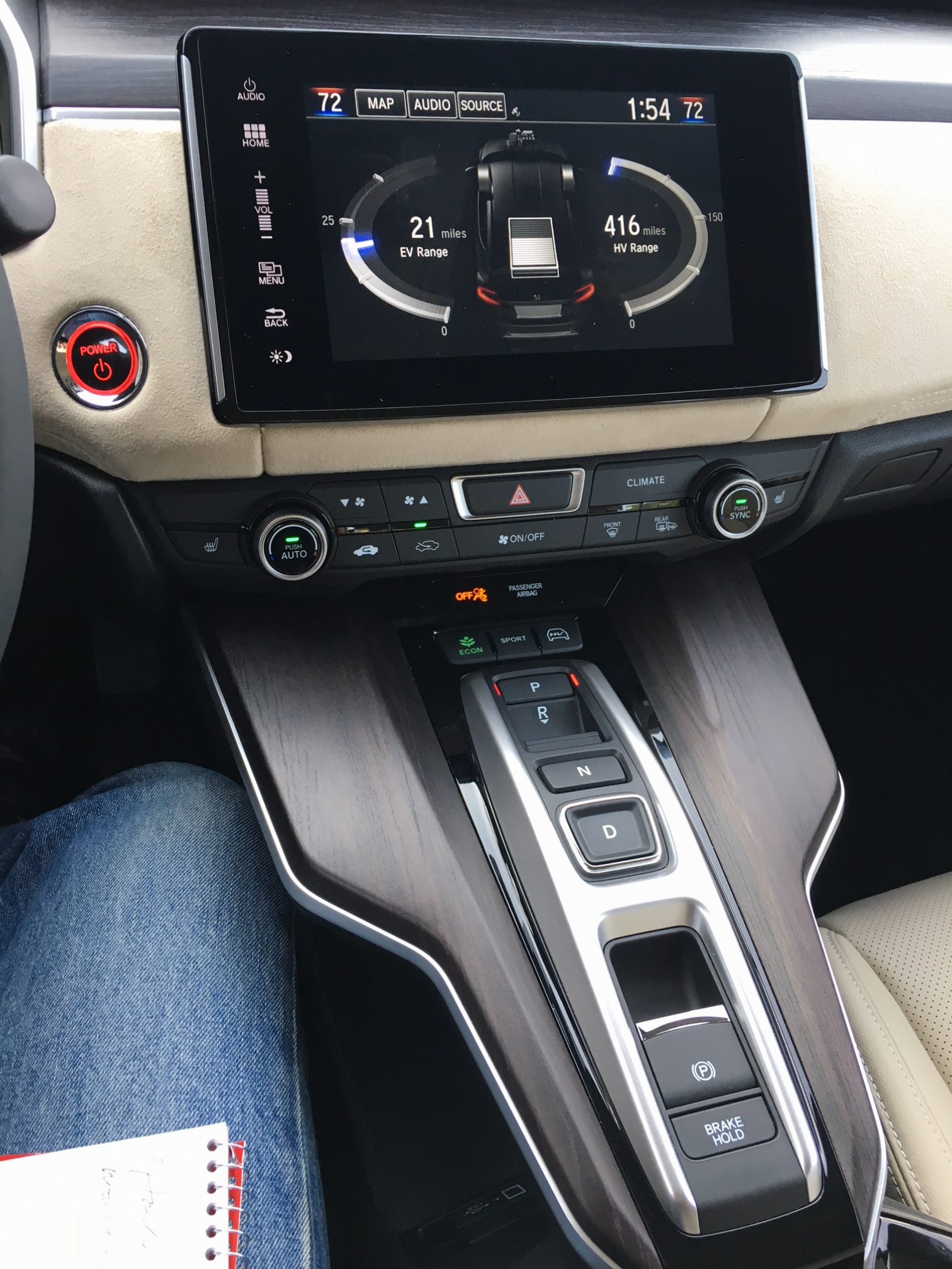
forward motion, that number begins to drop. By the time I got home from my 130-mile trip, it had diminished to below 100 mpg (still amazing for a hybrid). As I drove back and forth to work the following few days, the average crept back up again, until it achieved a remarkable 160.8 MPGe (miles per gallon equivalent) when I turned in the test car. It’s hard to argue with the wonderfulness of that.
One day, with combined errands, I was down to one mile of battery left, and watched the display hit 0. Then, the engine came on, just before I reached home. A 47-mile EV range is about perfect, but here, a 48-mile one would have done the job petrol-free.
According to EPA tests, a standard gasoline-powered sedan emits about 400 grams of CO2 per mile. The 2018 Honda Clarity Plug-in Hybrid, per www.fueleconomy.gov, puts out just 57. Other important numbers are 110 MPGe—the way EV energy use is measured with gasoline equivalent—and on gasoline alone, a still respectable 44 City, 40 Highway, and 42 Combined mpg. The green EPA scores are a perfect 10 for Greenhouse Gas; the Smog score wasn’t available yet, but is likely to be a 9 or a 10 as well.
Drive Choices
You can drive your Clarity every day without thinking about which fuel you’re using, but you can also take things into your own hands with three different driving modes, set with buttons on the center console.
- The EV mode disconnects the engine entirely, making the Clarity a pure EV (as long as there’s juice in the battery).
- Hybrid Mode means both halves of the powertrain run as needed based on driving and battery conditions. The gasoline engine is coupled and, along with the generator motor, either helps drive the car or charges the battery.
- Engine Drive mode hooks up the engine directly to the drivetrain fulltime, and is useful for cruising at medium to high speeds.
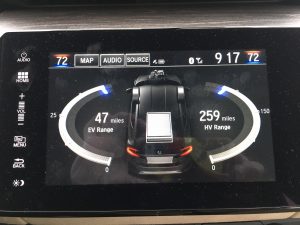
Then, there are three operating modes—Normal, Econ, and Sport, which allow you to configure your car for your personal priorities. Sport provides more responsive acceleration. Econ focuses on pure electric driving, and when the engine does come on, reduces throttle response to use less gas. Normal uses what Honda’s engineering team thinks is the best overall driving experience.
There’s another choice too—HV mode. Normally, the Clarity runs as a pure EV until the battery is depleted, except when a strong accelerator push turns on the engine for a quick burst of power. With a quick tap of the HV mode button, the car starts out as a hybrid and saves the electricity for later. This is ideal, for example, if you want to use engine power on 80 mph runs down Interstate 5 and then switch to pure EV driving around town when you arrive in Los Angeles.
In case you want to use the HV mode but your battery has a low charge, hold down the button longer, and the 2018 Honda Clarity Plug-in Hybrid will accumulate battery charge up to about 58 percent without using the electricity, after which it switches back to the normal HV mode, saving that charge until you need it.
New Tech Twists
Despite showing D, N, and R on the center console controls and instrument panel display, the Clarity PHEV doesn’t use a conventional transmission at all, saving weight and complexity. The controls and display do help you to select which way you’re going to move when you tap the accelerator.
Charging up is a snap. If you have access to a Level 2 (240-volt) charger, you can fill the battery from empty in just 2.5 hours. If you’re using Level 1 (120-volt) household current, it’ll take longer, but can easily be done overnight. I tried both. If you’re diligent, you can live in EV mode practically all the time. On the opposite end, if you drive the Clarity without charging at all, you’re still piloting a 40+ mpg hybrid.
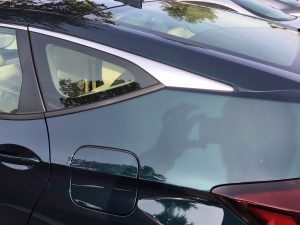
The 2018 Honda Clarity Plug-in Hybrid is an all-new, fresh design. The styling itself is futuristic and, to my eye, a bit overdone, although I did get used to looking at it. My tester came in Moonlit Forest Pearl, an exclusive color to the PHEV version of the Clarity. It looks black until sunlight hits it, when you see it’s really an elegant very dark green. It helps to mitigate some of the odd body shapes.
There are two trims—the well-equipped standard model and the Touring, which adds navigation, leather-trimmed seats and steering wheel, and power seat adjustments—eight-way for the driver and four-way for the passenger, with two-way driver memory.
All cars feature handsome 18-inch alloy wheels; LED lights all around, a sweet-sounding eight-speaker, 180-watt audio system, Bluetooth, rearview camera, dual automatic climate control and more. The upgraded tan suede dash panels on my Touring test car provided a real sense of luxury.
Interior Touches
The interior of the 2018 Honda Clarity Plug-in Hybrid feels big and wide, with a chiseled, sweeping dashboard running from door-to-door in this 73.9-inch wide car. You can fit three people comfortably in the rear seat. The trunk measures a generous 15.5 cubic feet because the batteries are relatively small and are under the car, not taking up cargo space.

The interior boasts a Volvo-inspired flying bridge console, with room below for a purse or a small parcel. The doors and dash are all nicely padded and the materials are fairly upscale and nicely coordinated. The only sour note for me was the grained plastic fake wood, which stood out as inauthentic amidst the otherwise posh accommodations. The doors slam with a satisfying “thunk.”
The instrument panel exhibits the clean look you expect from Honda. A silvery trim shape surrounds the gauges and is oddly asymmetrical to allow the “transmission” and EV information to display.
In town and on the highway, this Clarity rides whisper quiet. Honda engineers spent considerable time in the wind tunnel tweaking the aerodynamics, keeping airflow from being disturbed as it passes over the car. For example, the rakish cut of the partially covered rear wheel wells is meant to keep the air flowing smoothly over the rear wheels. Even the taillamps are aerodynamically tuned. Acoustic laminated windshield and front door glass help muffle outside noise as well.
Invisible Engineering
So many invisible engineering choices collectively make a difference. The Clarity uses an array of advanced materials in construction to make it about 15 percent lighter than a conventional midsize sedan. These include greater use of aluminum and plastic, and about 40 percent of the car is built from ultra-high-strength steel. You can’t see it, but it’s helping make the Clarity more efficient.
There’s a little startup sound when you press the Start button. Apple CarPlay popped up when prompted on the eight-inch center screen, although it did go on hiatus one of my test days. My wife thought the center display, which floats over the suede panel, to be intrusive, but car designers today seem to like the “here’s your tablet” look.

The instrument panel features the usual Charge/Power gauge front and center, so you can monitor your driving behavior. A center panel display shows where the energy is coming from and when the battery is charging, if you’re curious.
I noticed that the steering wheel would sometimes pulse in my hands. I discovered it was a form of lane departure warning, letting me know I was near a line. Otherwise, the electric power steering felt smooth and neutral.
The Price Point
Pricing starts at $34,290 for the standard trim and $37,490 for the Touring. Both prices include an $890 destination and handling charge. Those numbers are competitive, especially considering the spaciousness the car provides.
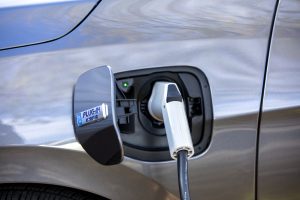
The Clarity currently offers three versions: Pure EV, Hydrogen Fuel Cell, and this new PHEV. The PHEV is likely to be the volume seller, as it’s practical for anyone who wants a highly efficient sedan, while the other two models appeal mostly to true believers. The EV model ekes out a disappointing 89 miles of range, while the Fuel Cell version is hampered by both a very limited fuel station infrastructure and fuel that is expensive compared to gasoline or electricity.
The Clarity trio just won Green Car Journal’s 2018 Green Car of the Year award, in recognition of offering three clean ways to go in one package.
Although pure electric vehicles will likely become the norm for most driving in the future, for now, plug-in hybrids like the 2018 Honda Clarity Plug-in Hybrid, with a decent electric-only range, offer a pain-free way to drive an EV most of the time and eliminate any excuse for not getting a green vehicle.
Related Stories You Might Enjoy:
Honda Clarity Family Wins Green Car of the Year
Flash Drive: 2017 Ford Fusion Energi
Flash Drive: 2018 Hyundai Ioniq PHEV
News: 2018 Kia Niro PHEV Introduced
Road Test: 2017 Kia Optima PHEV
Comparison Test: Ford Fusion Hybrid & Energi
Road Test: 2017 Chevrolet Volt
Road Test: 2017 Toyota Prius Prime
Disclosure:
Clean Fleet Report is loaned free test vehicles from automakers to evaluate, typically for a week at a time. Our road tests are based on this one-week drive of a new vehicle. Because of this we don’t address issues such as long-term reliability or total cost of ownership. In addition, we are often invited to manufacturer events highlighting new vehicles or technology. As part of these events we may be offered free transportation, lodging or meals. We do our best to present our unvarnished evaluations of vehicles and news irrespective of these inducements.
Our focus is on vehicles that offer the best fuel economy in their class, which leads us to emphasize electric cars, plug-in hybrids, hybrids and diesels. We also feature those efficient gas-powered vehicles that are among the top mpg vehicles in their class. In addition, we aim to offer reviews and news on advanced technology and the alternative fuel vehicle market. We welcome any feedback from vehicle owners and are dedicated to providing a forum for alternative viewpoints. Please let us know your views at publisher@cleanfleetreport.com.


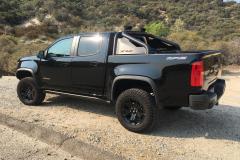








The horsepower numbers don’t make sense. 103 + 181 = 212 ?
@BoulderHybrids. Good observation. but those numbers are correct. It is not additive when you run a hybrid system because of losses and inefficiencies. You’ll see this in all hybrid systems. As I have had explained to me by engineers, the ICE also is linked to the electric motor so some of its horsepower is used to generate the electric motor horsepower and can’t be counted twice. Hope that helps. –ed.